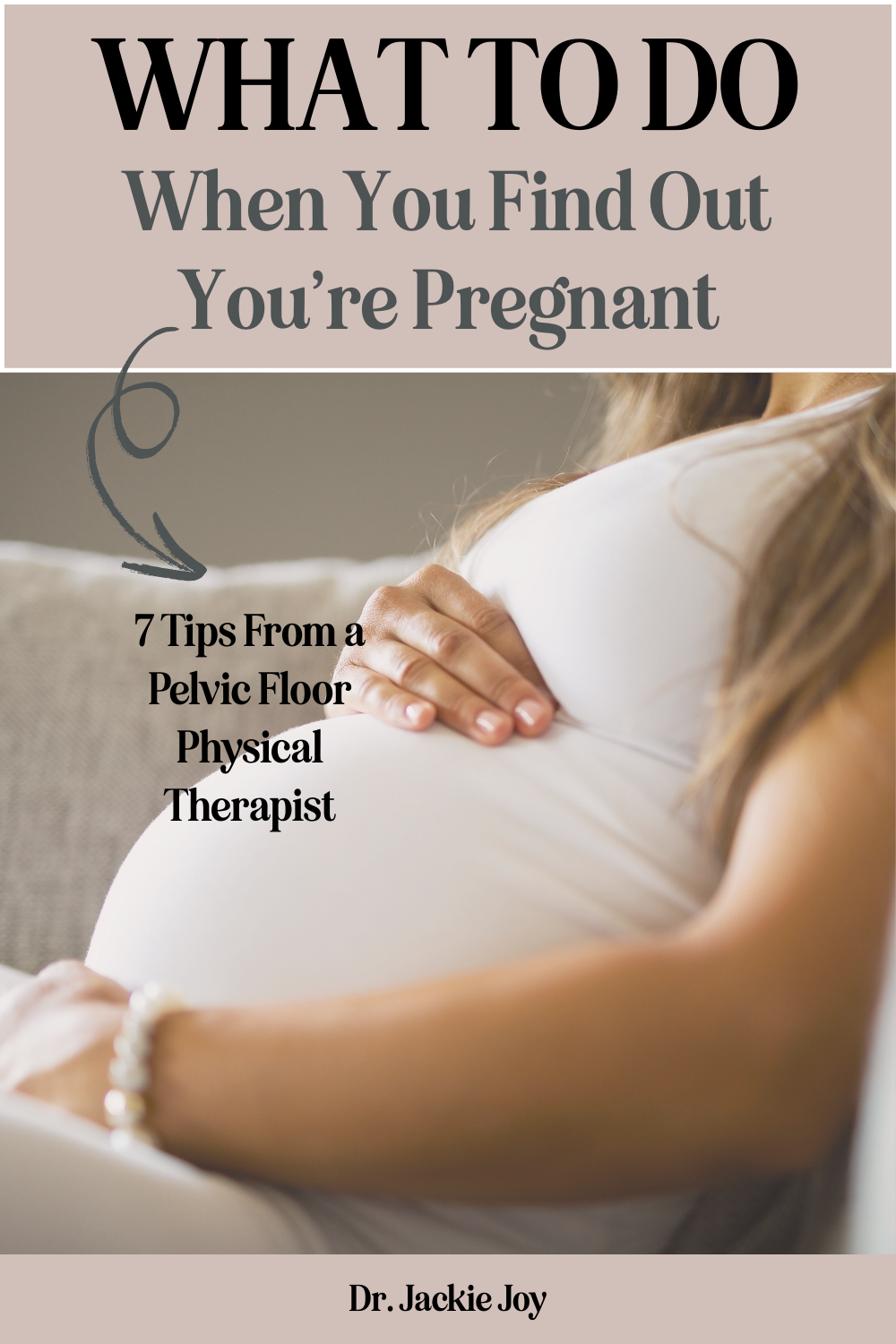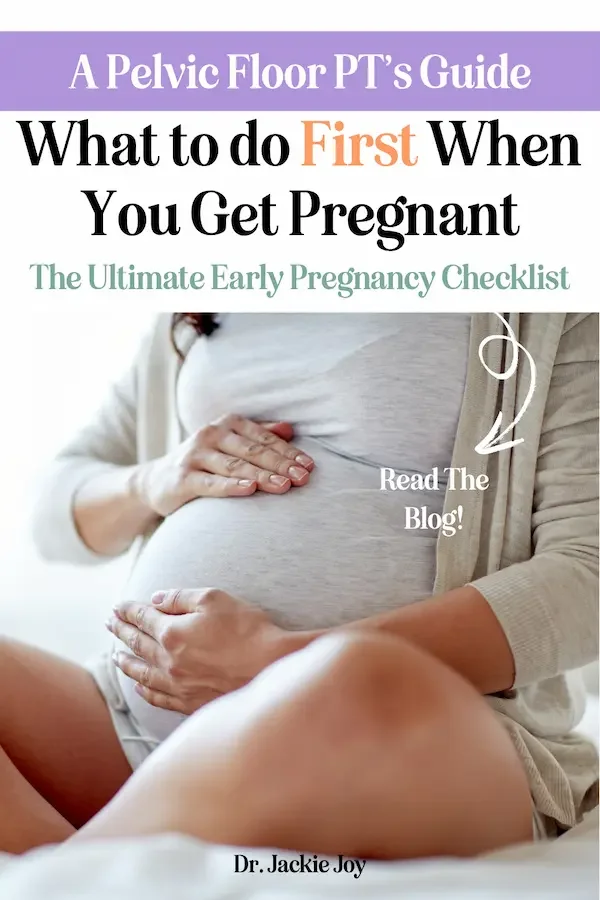What to do First When You Get Pregnant: A Pelvic Floor Therapist’s Ultimate Guide
Congrats! You’re pregnant! Now what?
I’m a pelvic floor physical therapist and mama of 2 who works with women in pregnancy (yes - as early as first trimester) and postpartum, and I’m VERY familiar with the deep dive google search after seeing that faint line.
You can stop googling now - I’m here to tell you exactly what to do first when you get pregnant. This early pregnancy checklist is designed to help take out the overwhelm of what to do when you find out you’re pregnant and help you start thinking ahead - without stressing out - starting as soon as you see the faint line.
Seeing that positive pregnancy test can elicit a lot of emotions:
Maybe you’re super excited - but so nervous about pregnancy - the nausea, the pain, the fatigue - how are you going to handle it all?
Maybe you’re not excited - you weren’t really planning this and aren’t sure if you are ready.
Maybe you had a tough pregnancy before, and are excited but not sure if your body can handle it.
Maybe you’re seeing the faint line and not sure if you can believe it because you’ve been struggling with infertility.
Maybe you’re recovering from a miscarriage and holding the weight of grief and anticipation at the same time (oof - I’ve been there), or not wanting to get too excited
And if it’s your first pregnancy, you are probably wondering what the heck you are supposed to do now. No one talks about this!
Pin me ⤵️
What to do When You Find Out You’re Pregnant
However you are feeling right now, finding out you are pregnant can be a lot.
You probably know some of the basics - like
Call your OB office to schedule an ultrasound
Stop drinking alcohol
Figure out what foods you should/shouldn’t be eating (honestly, you can probably relax on this one)
Unfortunately, there’s not much your OB can do for you until you go to that 8 or 9 week ultrasound. Which is typically a whole MONTH after you first find out you are pregnant.
But no worries - I got you.
1. Make sure you are taking a quality prenatal vitamin
Now is the time to educate yourself on the essentials of prenatal nutrition and make efforts to eat a diet high in protein, focus on blood sugar balance, and get the micronutrients you need for a healthy pregnancy - and to keep yourself from getting depleted.
While we really want you to be getting high quality, optimal amounts of nutrients from food, it is nearly impossible to meet the metabolic and micronutrient demands of your body in pregnancy with food alone (without adding a TON of stress).
Unfortunately most prenatal vitamins really do not stack up when it comes to yours and baby’s needs. They are in cheap formulations that aren’t well absorbed by the body, and only contain bare minimum amounts of nutrients - not what we want, ladies!
There are a few GOOD prenatals on the market - but even some with the most beautiful branding do not have optimal amounts of essential nutrients - like choline, for example.
My favorite prenatal vitamin to recommend to my pregnant is Needed because it has OPTIMAL - not just bare minimum amounts of all the micronutrients needed for every stage of pregnancy. The code DRJACKIEJOY will get you 20% off your first order (by the way, I don’t get a commission from this - it’s purely a discount code for you to enjoy)
For a deeper dive, and to see if your prenatal vitamin stacks up, You can check out my blog post - the Ultimate Guide to Prenatal vitamins
2. Explore Your Birth Options and Preferences
It may surprise you that I include this in your early pregnancy checklist - because you may not even know you have options (besides who you pick as your doctor).
I know birth seems so far off if you just found out you are pregnant, but now is the time to start educating yourself on things like:
Options for providers. Do you want an OB, or a Midwife?
What questions to ask when you interview providers to determine who is the right fit.
Birth settings - not just options for hospitals, but birth centers, and home birth (all of which are great options for first time moms if you are low-risk)
Common interventions and why they are done
Considering whether you want to have an epidural or an unmedicated birth (and how to prepare) to have the best chances of the birth that you want)
Thinking about your dream birth experience, determining what steps will be necessary to get as close to that dream experience as possible (we all know birth is out of our control, but we do have agency over the choices we make), will help you determine where you decide to give birth and who you choose as your provider.
Starting to think about this NOW will help you get a head start on birth preparation and planning, and make sure you feel aligned with the provider you choose.
3. Start a Pregnancy-Optimized Strength Training Program
I call BS on the advice to avoid lifting more than 20 lbs during pregnancy. Strength training should be on everyone’s early pregnancy checklist.
Before anyone asks - YES strength training (even high intensity strength training) is established to be safe and effective in pregnancy. Gone are the days where you should “just walk” or “just rest” unless you are explicitly told to do so for a medical reason or risk to your pregnancy.
We have plenty of evidence to back up the safety of exercise (even high intensity) in pregnancy, and we now even specifically have two systematic reviews (the highest quality scientific evidence) that show that there is NO relationship between exercising in the first trimester and miscarriage.
The benefits of strength training in pregnancy are many but here are just a couple of high points:
Higher levels of activity -> lower rates of gestational hypertension and preeclampsia
Higher levels of activity -> lower rates of complications at delivery
If you have already researched exercise during pregnancy, you may have heard “Don’t START anything new during pregnancy if you don’t have experience.” But I would argue that if you aren’t ALREADY strength training, pregnancy IS the time to start.
Not only is it beneficial to pregnancy and birth outcomes, it is important to:
prevent aches and pains in pregnancy
Strengthen your pelvic floor to be resilient to the effects of pregnancy and have an optimal postpartum recovery
Prepare for the physical demands of motherhood - your baby (who will soon be a toddler) and all the baby gear is HEAVY. You do not need to be throwing out your back slinging that Doona stroller into the car. Motherhood is a sport, and you need to train for it.
If you don’t have experience, no worries mama - I’m about to tell you exactly where to start.
4. Hire a Pelvic Floor Physical Therapist
One of the FIRST things I recommend you do when you first find out you’re pregnant is hire a pelvic floor physical therapist to prepare your pelvic floor for birth, prevent aches, pains, and leaking, and have a smooth postpartum recovery.
As a pelvic floor physical therapist who helps women stay pain-free and leak-free in pregnancy, strength training is the number one way we can prevent and manage the common pains and problems you hear about in pregnancy.
You also need stability training - or working on coordination and control over HOW the muscles are working.
You need a physical therapist on your prenatal team no matter how active you have been pre-pregnancy.
Here is why:
During pregnancy, your hormones shift dramatically, which impacts the mobility of your joints - this is purposeful, as we want your pelvis to be nice and mobile to open up when you give birth. However, this puts you at an increased risk for injury, because you need more muscular support to keep your body stable.
THAT BEING SAID - you really need to work on strength WITH stability - or, coordination and CONTROL over your muscles. I don’t actually care how heavy you can lift if you aren’t activating the right muscles. That is just throwing tension onto dysfunction.
This is exactly why you want to be working with a pelvic floor physical therapist throughout your entire pregnancy to examine your body and movement patterns to identify the risks of injury or pain you may have, like:
SI Joint pain
Symphysis pubis dysfunction (pain in the pubic bones that can make it super painful to walk)
Low back pain
Pelvic organ prolapse
Severe perineal tearing in birth
A pelvic floor physical therapist will be your very best friend in pregnancy because:
We have a vast knowledge of the musculoskeletal system (your bones and joints) with a special understanding of the pelvic floor and how it interacts with the rest of your body in pregnancy and postpartum
We are trained specialists in prescribing exercise (just like an MD prescribes pharmaceuticals) - if something hurts, we change the type of movement, if it’s too much, we change the dose.
We understand how the anatomy of your pelvis plays out in birth, and can help you prepare for an uncomplicated delivery with a smooth recovery.
You need a pelvic floor physical therapist on your team throughout your entire pregnancy to strengthen your core and pelvic floor, manage and prevent symptoms like back and rib pain, and prepare for a smooth birth and postpartum.
At the end of the day, if you know nothing else about pelvic floor physical therapy, please hear this:
Pain in pregnancy is NOT inevitable. You can enjoy it. Really. And pelvic floor physical therapist is the partner you need on your journey to make that happen.
When should you have your first appointment?
Any time in the first trimester is ideal.
We will really get to work at the end of first and throughout the second trimester on strengthening your pelvic floor and stabilizing your body for pain prevention and management.
In the third trimester, we will work on relaxing your pelvic floor and mobilizing your pelvis, hips, and spine, so that you can give baby the space he or she needs to have a smooth delivery.
5. Start Planning for Postpartum (don’t underestimate this!)
You may feel like the day you bring your baby home is so far off, but this is important: Pregnancy is hard, but postpartum can hit you like a hurricane if you aren’t prepared.
My advice? Spend at LEAST as much time preparing your postpartum space, support team, meals, and self-care as you do on designing your nursery.
Who will be available to help you?
Who do you WANT to help and support you in the early days (pro tip: I really recommend ONLY your mom/1-2 safe people in your space in the first 2 weeks)
What kind of professional support will you need/want? - eg, a postpartum doula, pelvic floor PT, lactation specialist
How do you want your first few weeks postpartum to feel as you bond with your baby?
Start thinking about preparing your postpartum space and recovery plan.
I recommend following the postpartum 5-5-5 rule, where you essentially focus on resting and bonding with baby as much as possible in the first 2 weeks postpartum (As someone who did NOT do this the first time, but did after my second baby, I can tell you it makes a WORLD of difference in your ongoing recovery)
During those first weeks, you’ll want to have a movement and recovery plan to start reconnecting to your body and core. While you don’t really need to worry about this right now, it’s good to start thinking about it. My Postpartum Recovery Guide has everything you will need to prepare for your physical recovery from birth, whether you have a vaginal delivery or a C Section, including guided videos with exercises you can start day one (from your bed!)
While you’re building your registry (I know you’ve already started!), make sure you put a few items for YOU on there - things like nursing bras, postpartum recovery supplies, and maybe even a fund for a doula, pelvic floor PT, and postpartum meals. My FREE postpartum recovery checklist has everything you need.
6. Research Birth Doulas
A birth doula is a person who supports you during pregnancy and birth. There are many doulas with different specialties and personalities, so you will want to get started thinking about who you would like to interview.
Do you need a doula? My honest opinion is - YES. Whether you want a medicated or unmedicated birth, in-hospital or out-of-hospital, you will want to have an additional person who can support you and your partner through this wild process of birth, advocate for you and your preferences, and help you feel in control of your experience.
7. Tell Safe Friends and Family
This is a bit controversial, but after experiencing two miscarriages, and supporting women throughout the first trimester, I think its time to break the stigma of telling people about your pregnancy early on. Of course, you want to make sure you share with people who are safe, but the first trimester can be really hard with all the symptoms- and emotions - and yes, pregnancy loss is unfortunately very common.
Now is a great time to tell just a few people who can support you through the first trimester before you make your announcement more public, who can be with you in all the highs and lows of your motherhood journey.
Final Thoughts
There you go- that’s your early pregnancy checklist to help you know what to do first when you get pregnant!
I hope this helps you know exactly what to do when you find out you are pregnant - and guides you to some of the many helpful tools available to you.
Pin me ⤵️
Ready for more support?
Hi! I’m Dr. Jackie Roelofs - a doctor of physical therapy specializing in the pelvic floor in pregnancy, postpartum and beyond. My C-section recovery programs are available in person in New Orleans, and worldwide through my fully digital postpartum programs.
If you are craving support after undergoing one of the biggest transformations of your life, fill out a contact form and I’ll reach out to you within 2 business days.
If you are within the first 6 weeks postpartum, make sure you check out my E-Book, Rest, Breathe, Begin: a postpartum recovery guide for those first few weeks at home with baby. It includes exercises you can do from your own bed to reconnect to your core, reduce pain, and kickstart your recovery and return to exercise after C-section.
Are we friends on Instagram? Make sure you are following and shoot me a DM with any questions - I love to hear from you.
Next on your reading list:
The Best Pelvic Floor Exercises for Pregnancy- a few of my favorite exercises to help you reduce pain, prepare for birth, and set yourself up for a smooth postpartum recovery
Supplementing for a Healthy Pregnancy- the ultimate guide to essential prenatal nutrition and choosing a prenatal vitamin
SPD in Pregnancy - understand SPD in pregnancy and learn about 3 of the best exerciess to help
If you want to stay connected, make sure to Follow me on Instagram @drjuicyjackie for more expert (and no-TMI) postpartum advice.





